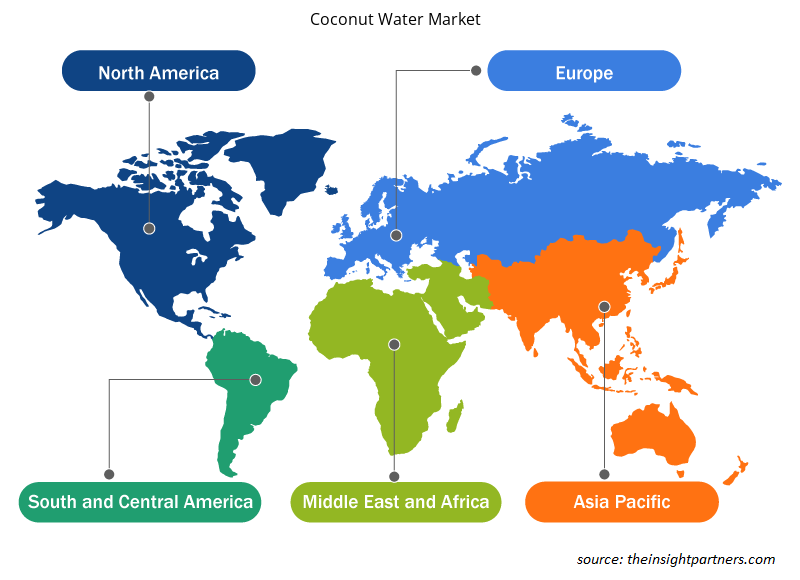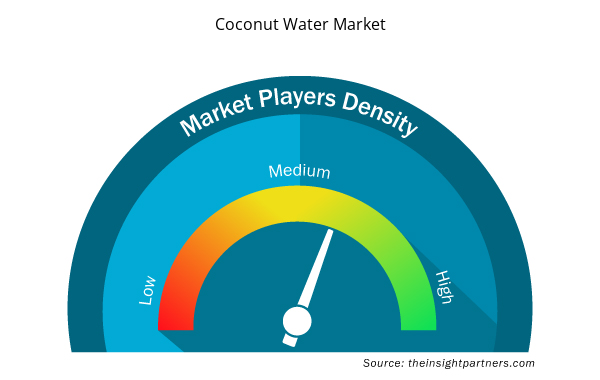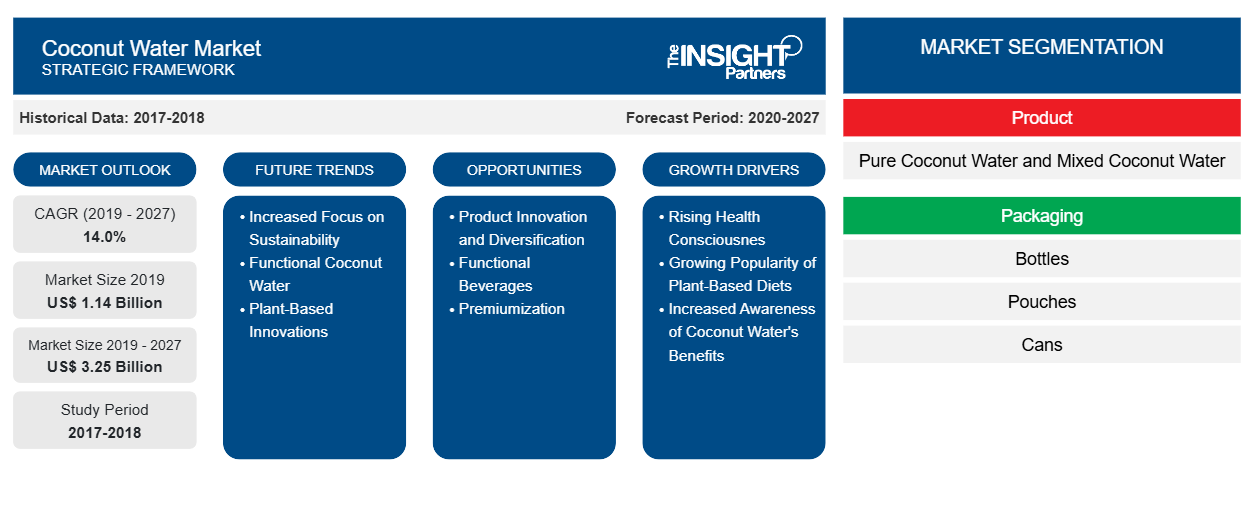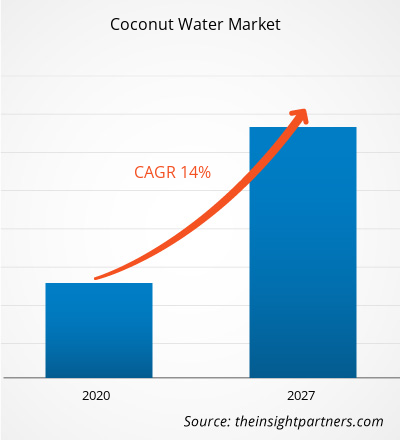El mercado de agua de coco se valoró en US$ 1.142,09 millones en 2019 y se proyecta que alcance los US$ 3.246,64 millones en 2027; se espera que crezca a una CAGR del 14,0% entre 2020 y 2027.
El agua de coco se utiliza para enriquecer y funcionalizar nutricionalmente una amplia gama de productos alimenticios y bebidas, incluidas barras nutritivas, cereales, productos lácteos, productos horneados, bebidas, bocadillos, salsas y recetas de sopas. Es baja en calorías y libre de grasas y colesterol. Se espera que el mercado mundial de agua de coco en América del Norte crezca a la CAGR más alta del 14,7 % durante 2020-2027. El consumo de agua de coco está aumentando debido a los beneficios para la salud asociados con ella, lo que impulsa el crecimiento del mercado.
La pandemia de COVID-19 se informó por primera vez en Wuhan (China) en diciembre de 2019. A junio de 2020, Estados Unidos, Rusia, India, China, Italia, Francia y Alemania se encuentran entre los países más afectados en términos de casos positivos y muertes reportadas. Según las cifras de la OMS actualizadas en junio de 2020, se han reportado ~7,482,952 casos confirmados y ~419,497 muertes a nivel mundial. El brote ha afectado a las economías e industrias debido a bloqueos , prohibiciones de viaje y cierres de negocios. Alimentos y bebidas es una de las principales industrias del mundo que sufre graves interrupciones en forma de interrupciones de la cadena de suministro, cancelaciones de eventos tecnológicos y cierres de oficinas. Aunque China es el centro de fabricación mundial y el mayor proveedor de materias primas para varias industrias en el mundo, también es uno de los países más afectados por la pandemia de COVID-19. El cierre de varias plantas y fábricas en China está afectando negativamente a las cadenas de suministro globales y a la fabricación y venta de varios productos alimenticios y bebidas. El colapso general del mercado debido a este brote también está restringiendo el crecimiento del mercado de agua de coco debido al cierre de fábricas, obstáculos en las cadenas de suministro y la desaceleración de la economía mundial.
Personalice este informe según sus necesidades
Obtendrá personalización en cualquier informe, sin cargo, incluidas partes de este informe o análisis a nivel de país, paquete de datos de Excel, así como también grandes ofertas y descuentos para empresas emergentes y universidades.
- Obtenga las principales tendencias clave del mercado de este informe.Esta muestra GRATUITA incluirá análisis de datos, desde tendencias del mercado hasta estimaciones y pronósticos.
Perspectivas del mercado
Los beneficios del agua de coco para la salud impulsan el crecimiento del mercado
El agua de coco no contiene colesterol ni grasas. Se considera una bebida deportiva natural debido a su alto contenido de electrolitos, como potasio, calcio, sodio y magnesio, que ayudan a regular el equilibrio de líquidos, prevenir la deshidratación y garantizar el funcionamiento adecuado de los músculos. El alto contenido de potasio también favorece la salud del corazón y protege a los consumidores contra el riesgo de sufrir un derrame cerebral al reducir la presión arterial. Los profesionales de la salud y los dietistas recomiendan a los pacientes consumir agua de coco en lugar de bebidas azucaradas.
Información sobre el tipo de producto
Según el tipo de producto, el mercado del agua de coco se divide en agua de coco pura y agua de coco mezclada. El segmento de agua de coco pura representó una mayor participación del mercado en 2019. El agua de coco pura, también conocida como agua de coco orgánica, es más saludable que el agua de coco mezclada o convencional. En su forma natural, se la conoce como una fuente rica de sodio, potasio y magnesio, que optimizan el proceso de rehidratación .
Perspectivas sobre embalajes
Según el envase, el mercado del agua de coco se segmenta en botellas, bolsas y latas. El segmento de las botellas representó la mayor parte del mercado en 2019. Con alternativas que van desde 50 ml a 1 L, el envase embotellado ha sido una de las opciones preferidas tanto por los consumidores como por los fabricantes. Las botellas de tamaño pequeño son fáciles de transportar y pueden almacenar un volumen adecuado de agua de coco. Las botellas también son fáciles de transportar a granel, ya que no se dañan fácilmente. Las tapas de botellas selladas ayudan a extender la vida útil del agua de coco durante algún tiempo, lo que impulsa la demanda de agua de coco embotellada a nivel mundial.
Perspectivas regionales del mercado del agua de coco
Los analistas de Insight Partners explicaron detalladamente las tendencias y los factores regionales que influyen en el mercado del agua de coco durante el período de pronóstico. Esta sección también analiza los segmentos y la geografía del mercado del agua de coco en América del Norte, Europa, Asia Pacífico, Oriente Medio y África, y América del Sur y Central.

- Obtenga los datos regionales específicos para el mercado del agua de coco
Alcance del informe sobre el mercado del agua de coco
| Atributo del informe | Detalles |
|---|---|
| Tamaño del mercado en 2019 | 1.140 millones de dólares estadounidenses |
| Tamaño del mercado en 2027 | US$ 3.25 mil millones |
| CAGR global (2019-2027) | 14,0% |
| Datos históricos | 2017-2018 |
| Período de pronóstico | 2020-2027 |
| Segmentos cubiertos | Por producto
|
| Regiones y países cubiertos | América del norte
|
| Líderes del mercado y perfiles de empresas clave |
|
Densidad de actores del mercado: comprensión de su impacto en la dinámica empresarial
El mercado del agua de coco está creciendo rápidamente, impulsado por la creciente demanda de los usuarios finales debido a factores como la evolución de las preferencias de los consumidores, los avances tecnológicos y una mayor conciencia de los beneficios del producto. A medida que aumenta la demanda, las empresas amplían sus ofertas, innovan para satisfacer las necesidades de los consumidores y aprovechan las tendencias emergentes, lo que impulsa aún más el crecimiento del mercado.
La densidad de actores del mercado se refiere a la distribución de las empresas o firmas que operan dentro de un mercado o industria en particular. Indica cuántos competidores (actores del mercado) están presentes en un espacio de mercado determinado en relación con su tamaño o valor total de mercado.
Las principales empresas que operan en el mercado del agua de coco son:
- Amy y Brian
- PepsiCo, Inc.
- La Compañía Coca-Cola
- Agua de coco pura C2O
- Gracia Kennedy
Descargo de responsabilidad : Las empresas enumeradas anteriormente no están clasificadas en ningún orden particular.

- Obtenga una descripción general de los principales actores clave del mercado del agua de coco
Mercado de agua de coco por tipo de producto
- Agua de coco pura
- Agua de coco mixta
Mercado de agua de coco, por envase
- Botellas
- Bolsas
- Latas
Mercado de agua de coco por canal de distribución
- Supermercados e Hipermercados
- Tienda de conveniencia
- En línea
- Otros
Perfiles de empresas
- Amy y Brian
- PepsiCo, Inc.
- La Compañía Coca-Cola
- Agua de coco pura C2O
- Gracia Kennedy
- Green Coco Europe GmbH
- Cosecha inofensiva
- Productos orgánicos de Mojo Inc.
- Saborea el Nirvana
- Grupo Sambu
- Análisis histórico (2 años), año base, pronóstico (7 años) con CAGR
- Análisis PEST y FODA
- Tamaño del mercado Valor/volumen: global, regional, nacional
- Industria y panorama competitivo
- Conjunto de datos de Excel



Report Coverage
Revenue forecast, Company Analysis, Industry landscape, Growth factors, and Trends

Segment Covered
This text is related
to segments covered.

Regional Scope
North America, Europe, Asia Pacific, Middle East & Africa, South & Central America

Country Scope
This text is related
to country scope.
Preguntas frecuentes
Pure coconut water, also known as organic coconut water, is healthier as compared to mixed or conventional coconut water. In its natural form, the pure coconut water is known to be a rich source of sodium, potassium, and magnesium that proves to be most beneficial for rehydration.
Amy and Brian, PepsiCo, Inc., The Coca-Cola Company, C2O Pure Coconut Water, Gracekennedy, Green Coco Europe GmbH, Harmless Harvest, Mojo Organics Inc., Taste Nirvana, and Sambu Group are among the well-established players in the global coconut water market.
In 2019,the coconut water market was predominantinAsia Pacificat theglobal level.With an expansion in the number of multinational companies setting up their manufacturing plant in the Asia Pacific region, the market development for these products is anticipated to grow during the forecast period.
Trends and growth analysis reports related to Food and Beverages : READ MORE..
The List of Companies - Global Coconut Water Market
- Amy and Brian
- PepsiCo, Inc.
- The Coca-Cola Company
- C2O Pure Coconut Water
- Gracekennedy
- Green Coco Europe GmbH
- Harmless Harvest
- Mojo Organics Inc.
- Taste Nirvana
- Sambu Group
The Insight Partners performs research in 4 major stages: Data Collection & Secondary Research, Primary Research, Data Analysis and Data Triangulation & Final Review.
- Data Collection and Secondary Research:
As a market research and consulting firm operating from a decade, we have published and advised several client across the globe. First step for any study will start with an assessment of currently available data and insights from existing reports. Further, historical and current market information is collected from Investor Presentations, Annual Reports, SEC Filings, etc., and other information related to company’s performance and market positioning are gathered from Paid Databases (Factiva, Hoovers, and Reuters) and various other publications available in public domain.
Several associations trade associates, technical forums, institutes, societies and organization are accessed to gain technical as well as market related insights through their publications such as research papers, blogs and press releases related to the studies are referred to get cues about the market. Further, white papers, journals, magazines, and other news articles published in last 3 years are scrutinized and analyzed to understand the current market trends.
- Primary Research:
The primarily interview analysis comprise of data obtained from industry participants interview and answers to survey questions gathered by in-house primary team.
For primary research, interviews are conducted with industry experts/CEOs/Marketing Managers/VPs/Subject Matter Experts from both demand and supply side to get a 360-degree view of the market. The primary team conducts several interviews based on the complexity of the markets to understand the various market trends and dynamics which makes research more credible and precise.
A typical research interview fulfils the following functions:
- Provides first-hand information on the market size, market trends, growth trends, competitive landscape, and outlook
- Validates and strengthens in-house secondary research findings
- Develops the analysis team’s expertise and market understanding
Primary research involves email interactions and telephone interviews for each market, category, segment, and sub-segment across geographies. The participants who typically take part in such a process include, but are not limited to:
- Industry participants: VPs, business development managers, market intelligence managers and national sales managers
- Outside experts: Valuation experts, research analysts and key opinion leaders specializing in the electronics and semiconductor industry.
Below is the breakup of our primary respondents by company, designation, and region:

Once we receive the confirmation from primary research sources or primary respondents, we finalize the base year market estimation and forecast the data as per the macroeconomic and microeconomic factors assessed during data collection.
- Data Analysis:
Once data is validated through both secondary as well as primary respondents, we finalize the market estimations by hypothesis formulation and factor analysis at regional and country level.
- Macro-Economic Factor Analysis:
We analyse macroeconomic indicators such the gross domestic product (GDP), increase in the demand for goods and services across industries, technological advancement, regional economic growth, governmental policies, the influence of COVID-19, PEST analysis, and other aspects. This analysis aids in setting benchmarks for various nations/regions and approximating market splits. Additionally, the general trend of the aforementioned components aid in determining the market's development possibilities.
- Country Level Data:
Various factors that are especially aligned to the country are taken into account to determine the market size for a certain area and country, including the presence of vendors, such as headquarters and offices, the country's GDP, demand patterns, and industry growth. To comprehend the market dynamics for the nation, a number of growth variables, inhibitors, application areas, and current market trends are researched. The aforementioned elements aid in determining the country's overall market's growth potential.
- Company Profile:
The “Table of Contents” is formulated by listing and analyzing more than 25 - 30 companies operating in the market ecosystem across geographies. However, we profile only 10 companies as a standard practice in our syndicate reports. These 10 companies comprise leading, emerging, and regional players. Nonetheless, our analysis is not restricted to the 10 listed companies, we also analyze other companies present in the market to develop a holistic view and understand the prevailing trends. The “Company Profiles” section in the report covers key facts, business description, products & services, financial information, SWOT analysis, and key developments. The financial information presented is extracted from the annual reports and official documents of the publicly listed companies. Upon collecting the information for the sections of respective companies, we verify them via various primary sources and then compile the data in respective company profiles. The company level information helps us in deriving the base number as well as in forecasting the market size.
- Developing Base Number:
Aggregation of sales statistics (2020-2022) and macro-economic factor, and other secondary and primary research insights are utilized to arrive at base number and related market shares for 2022. The data gaps are identified in this step and relevant market data is analyzed, collected from paid primary interviews or databases. On finalizing the base year market size, forecasts are developed on the basis of macro-economic, industry and market growth factors and company level analysis.
- Data Triangulation and Final Review:
The market findings and base year market size calculations are validated from supply as well as demand side. Demand side validations are based on macro-economic factor analysis and benchmarks for respective regions and countries. In case of supply side validations, revenues of major companies are estimated (in case not available) based on industry benchmark, approximate number of employees, product portfolio, and primary interviews revenues are gathered. Further revenue from target product/service segment is assessed to avoid overshooting of market statistics. In case of heavy deviations between supply and demand side values, all thes steps are repeated to achieve synchronization.
We follow an iterative model, wherein we share our research findings with Subject Matter Experts (SME’s) and Key Opinion Leaders (KOLs) until consensus view of the market is not formulated – this model negates any drastic deviation in the opinions of experts. Only validated and universally acceptable research findings are quoted in our reports.
We have important check points that we use to validate our research findings – which we call – data triangulation, where we validate the information, we generate from secondary sources with primary interviews and then we re-validate with our internal data bases and Subject matter experts. This comprehensive model enables us to deliver high quality, reliable data in shortest possible time.


 Obtenga una muestra gratuita de este informe
Obtenga una muestra gratuita de este informe